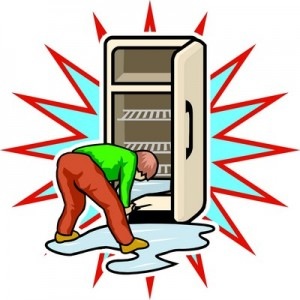 The power is out all over town. Hurricane Irene has downed power lines up and down the East Coast and I’m sure many of you are wondering what to do with all that food in your fridge and freezer.
The power is out all over town. Hurricane Irene has downed power lines up and down the East Coast and I’m sure many of you are wondering what to do with all that food in your fridge and freezer.
From numerous past experiences I know that one of the challenges in the aftermath of a power failure is figuring out what to do with the food in the fridge and freezer.
The Basic Rules For Leftovers
If you cooked up a storm right before the actual storm (or whatever caused the power failure), according to the March 2010 edition of the Nutrition Action Healthletter (Center for Science in the Public Interest), you should follow these general rules:
- The mantra is: 2 Hours–2 Inches–4 Days
- 2 Hours from oven to refrigerator: Refrigerate or freeze your leftovers within 2 hours of cooking. Throw them away if they are out longer than that.
- 2 Inches thick to cool it quick: Store your food at a shallow depth–about 2 inches–to speed chilling.
- 4 Days in the refrigerator–otherwise freeze it: use your leftovers that are stored in the fridge within 4 days. The exceptions are stuffing and gravy– which should be used within 2 days. Reheat solid leftovers to 165 degrees F and liquid leftovers to a rolling boil. Toss what you don’t finish.
Food Safety
The following food safety information is from the CDC:
- If power is out for less than two hours food in the refrigerator and freezer will be safe to eat. While the power is out keep the refrigerator and freezer doors closed as much as possible. This helps to keep food cold for a longer period of time.
- The refrigerator will keep food safely cold for about four hours if it is unopened. A full freezer will hold the temperature for approximately 48 hours (24 hours if it is half full) if the door remains closed.
- If power is out for longer than 2 hours follow these guidelines:
- Freezer: “A freezer that is half full will hold food safely for up to 24 hours. A full freezer will hold food safely for 48 hours. Do not open the freezer door if you can avoid it.”
- Refrigerator: “Pack milk, other dairy products, meat, fish, eggs, gravy, and spoilable leftovers into a cooler surrounded by ice. Inexpensive Styrofoam coolers are fine for this purpose. Use a food thermometer to check the temperature of your food right before you cook or eat it. Throw away any food that has a temperature of more than 40 degrees Fahrenheit.”
Can Thawed Or Partially Thawed Food In The Freezer Be Frozen Again?
According to the USDA: “food may be safely refrozen if the food still contains ice crystals or is at 40 °F or below. You will have to evaluate each item separately. Be sure to discard any items in either the freezer or the refrigerator that have come into contact with raw meat juices. Partial thawing and refreezing may reduce the quality of some food, but the food will remain safe to eat. See the attached charts for specific recommendations.”
What If Flood Water Covered Food Stored On Shelves And In Cabinets?
According to the USDA follow these guidelines for what can be kept or should be thrown out: “Do not eat any food that may have come into contact with flood water. Discard any food that is not in a waterproof container if there is any chance that it has come into contact with flood water. Food containers that are not waterproof include those with screw-caps, snap lids, pull tops, and crimped caps. Also, discard cardboard juice/milk/baby formula boxes and home canned foods if they have come in contact with flood water, because they cannot be effectively cleaned and sanitized.”
For more specific information please visit this USDA site.